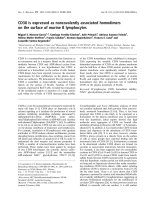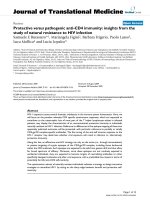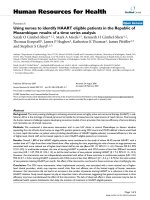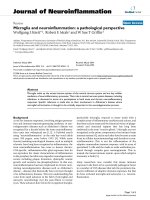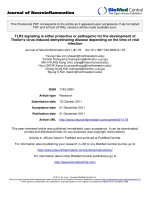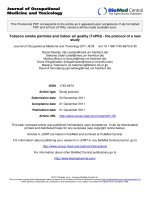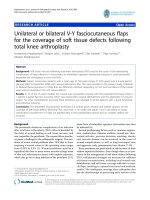Báo cáo toán học: " Spin-related tunneling through a nanostructured electric-magnetic barrier on the surface of a topological insulator" potx
Bạn đang xem bản rút gọn của tài liệu. Xem và tải ngay bản đầy đủ của tài liệu tại đây (701.67 KB, 18 trang )
This Provisional PDF corresponds to the article as it appeared upon acceptance. Fully formatted
PDF and full text (HTML) versions will be made available soon.
Spin-related tunneling through a nanostructured electric-magnetic barrier on the
surface of a topological insulator
Nanoscale Research Letters 2012, 7:90 doi:10.1186/1556-276X-7-90
Zhenhua Wu ()
Jun Li ()
ISSN 1556-276X
Article type Nano Express
Submission date 30 August 2011
Acceptance date 27 January 2012
Publication date 27 January 2012
Article URL />This peer-reviewed article was published immediately upon acceptance. It can be downloaded,
printed and distributed freely for any purposes (see copyright notice below).
Articles in Nanoscale Research Letters are listed in PubMed and archived at PubMed Central.
For information about publishing your research in Nanoscale Research Letters go to
/>For information about other SpringerOpen publications go to
Nanoscale Research Letters
© 2012 Wu and Li ; licensee Springer.
This is an open access article distributed under the terms of the Creative Commons Attribution License ( />which permits unrestricted use, distribution, and reproduction in any medium, provided the original work is properly cited.
Spin-related tunneling through a nanostructured
electric–magnetic barrier on the surface of a topological insulator
Zhenhua Wu
∗1,2
and Jun Li
3
1
SKLSM, Institute of Semiconductors, Chinese Academy
of Sciences, P.O. Box 912, Beijing 100083, China
2
CAE Team, Semiconductor R&D Center, Samsung
Electronics Co., Ltd., Gyeonggi-Do, Korea
3
Department of Physics, Semiconductor Photonics Research
Center, Xiamen University, Xiamen 361005, China
∗
Corresponding author:
Email address:
JL:
Abstract
We investigate quantum tunneling through a single electric and/or magnetic barrier
on the surface of a three-dimensional topological insulator. We found that (1) the
propagating behavior of electrons in such system exhibits a strong dependence on
the direction of the incident electron wavevector and incident energy, giving the
possibility to construct a wave vector and/or energy filter; (2) the spin orientation
can be tuned by changing the magnetic barrier structure as well as the incident
angles and energies.
PACS numbers: 72.25.Dc; 73.20 r; 73.23 b; 75.70 i.
2
1. Introduction
The recent discovery of a new quantum state of matter, topological insulator, has gen-
erated a lot of interest due to its great scientific and technological imp ortance [1–5]. In a
topological insulator, spin–orbit coupling opens an energy gap in the bulk, and results in
helical surface states residing in the bulk gap in the absence of magnetic fields. Such surface
states are spin-dependent and are topologically protected by time-reversal symmetry [4–7]
and distinct from conventional surface states, which are fragile and depend sensitively on the
details of the surface geometry and bonding. This discovery sparked intensive experimental
and theoretical interests, both for its fundamental novel electronics properties as well as
possible applications in a new generation of electric devices.
Very recently, the surface states in Bi-based alloys, Bi
1−x
Sb
x
, Bi
2
Se
3
, Bi
2
Te
3
, were were
theoretically predicted [6, 8] and experimentally observed by using angle-resolved photoe-
mission spectroscopy (ARPES) [9–12]. These 3D topological insulators have robust and
simple surface states consisting of a single Dirac cone at the Γ point [8]. Note that this
Hamiltonian appears similar to graphene [13], but topological insulators have an odd num-
ber of massless Dirac cones on the surface, ensured by the Z
2
topological invariant of the
bulk, while graphene has twofold massless Dirac cones at the K and K
valleys. Another
essential difference is connected with spin-related properties. In the surface, Hamiltonian of
the 3D TI σ acts on the real spin of the charge carriers, while for graphene it stands for the
pseudo spin, i.e., the A and B sublattices of graphene. Hence, it is natural to manipulate
spin transport on the surface of a 3D topological insulator by controlling the electron orbital
motion. Based on the topological surface Hamiltonian, it is clear that σ · k is a quantum
conserved quantity which implies that spin and momentum of the electron are locked. For
3
instance in a tunneling process, the reflected electron will reverse its spin due to the helical
property of the surface states, i.e., the spin-momentum locking [14]. This feature will lead to
some interesting phenomena, such as the spin-dependent conductance [15] and the twisted
RKKY interaction [16].
In this study, we investigate electron tunneling through single electric and magnetic
potential barriers which can be created by depositing a ferromagnetic metallic strip on
the surface of a 3D topological insulator. We find that the in-plane spin orientation of the
transmitted and the reflected electrons can be rotated over certain angles that are determined
by the incident angle and energy. Our results demonstrate that the magnetic field of the
magnetic barrier bends the trajectory of the electrons, and therefore rotate the spin.
2. Theory
First we focus on the electron transmission through a single electric and magnetic poten-
tial barrier on the surface of a 3D topological insulator, as shown in Figure 1. We can create
magnetic and electric potentials underneath a superconducting plate and a ferromagnetic
strip [17, 18]. The relevant magnetic and electric fields are directed perpendicular to the
surface of the 3D TI, i.e., V (x) = V [Θ(x) −Θ(x −d)]/2 and B
z
(x) = B[Θ(x) −Θ(x −d)]/2,
where Θ is the Heaviside step function. The magnetic field is perpendicular to the surface
and the Landau gauge A = (0, Bx, 0) is adopted in our calculation. The low-energy elec-
trons near the Γ point of the Dirac cones can be well described by the effective Hamiltonian
[19],
H = v
F
σ ·(π × z) + V + H
Z
, (1)
4
where v
F
is the Fermi velocity, σ
i
(i = x, y, z) are the Pauli matrices, V is the gate voltage
applied on the magnetic metal strips, and the last term H
Z
≡ gµ
B
σ·B is induced by Zeeman
spin spitting. Note that for g = 23 in Bi
2
Se
3
, the Zeeman term affects the transmission
slightly at low magnetic field. The momentum is π= p + eA, where the vector potential
of the inhomogeneous magnetic field generated by the magnetic metal stripe, z, is the unit
vector normal to the surface. Note that [σ ·(π ×z), H] = 0, which implies that σ ·(π ×z) is
a quantum conserved quantity during the tunneling processes, i.e., spin-momentum locking.
If the incident electrons are spin polarized along the direction of the vector (π × z), the
magnetic field bends the trajectory of the electrons, resulting in a rotation of the spin of
the transmitted electrons. The reflected electrons suffer similar spin rotations accompanied
by the reversal of the momentum p
x
. Interestingly, the gate voltage can be used to control
the reflection and transmission, and therefore tune the spin polarization of the reflected and
transmitted electrons.
For simplicity, we introduce the dimensionless units: l
B
= [ /eB
0
]
1/2
, B(x) → B
0
B(x),
A
y
(x) → B
0
l
B
A
y
(x), E → E
0
E, r → l
B
r, k → k/l
B
, and rewrite the Hamiltonian as
H =
V + gµ
B
B k
y
+ A
y
+ ik
x
k
y
+ A
y
− ik
x
V − gµ
B
B
. (2)
In the presence of the magnetic–electric potentials, the wavevector satisfies k
2
x
+(k
y
+A
y
)
2
=
(E −V )
2
−(gµ
B
B)
2
. Note that the translational invariance along the y direction gives rise
to conservation of k
y
, and thus the solutions can be written as ψ(x, y) = ψ(x)e
ik
y
y
. In the
5
free region, the eigenvalues are E
±
= ±v
F
π, and the corresponding eigenvectors are
ψ
L
(x) =
1
√
2
1
−ik
x
+(k
y
+A
y
)
E
F
−V
e
ik
x
x
(3)
+
r
√
2
1
ik
x
+(k
y
+A
y
)
E
F
−V
e
−ik
x
x
,
ψ
R
(x) =
t
√
2
1
−ik
x
+(k
y
+A
y
)
E
F
−V
e
ik
x
x
. (4)
In the barrier region the vector potential is A = (0, Bx, 0) and the solution can be expressed
in terms of parabolic cylinder functions D
ν
,
ψ =
±
c
±
D
υ/2−1
[±
√
2(x + k
y
)]
±
2
υ
D
υ/2
[±
√
2(x + k
y
)]
, (5)
with complex coefficients c
±
and υ ≡ (E
F
−V )
2
−(gµ
B
B)
2
. After some lengthy algebra, all
of the above coefficients of the wave functions can be obtained from the boundary conditions.
3. Spin and momentum filtering
First we consider that the incident electrons are spin polarized along the direction of the
vector (π × z), i.e., perpendicular to the direction of the electron motion. We examine the
transmission characteristics for a pure electric barrier (B = 0, V = 4), which are shown
in Figure 2a,b. In Figure 2a we plot the transmission probability as a function of the
incident angle and energy. The symmetry of the low-energy effective Hamiltonian when
A = 0 ensures the invariance of the transmission with respect to k
y
→ −k
y
. Note that,
perfect transmission always exists in the vicinity of normal incidence, i.e., this is the so-
called Klein tunneling, induced by the helical property of the Dirac fermion. This perfect
6
tunneling process can even occur for a low incident energy, and a high and wide barrier.
Figure 2b shows the spin orientation as a function of the incident angles and the incident
energies. From the spin orientation one can see that the transmitted electron spins are
polarized along the same direction as the incident electron spin, indicating that a pure
electric barrier without magnetic field will not affect the spin orientation, the reason is that
an electric barrier cannot bend the trajectories of the electrons and the outgoing electrons
will propagate in the same direction as the incident ones. The spin of the reflected electron,
with reversed longitudinal wavevector and conserved transverse wavevector, is rotated due
to the spin-momentum locking.
Next we consider the tunneling process through a pure magnetic single barrier. The
transmission probability is shown in Figure 3a for a magnetic barrier (B = 1) with width
d = 1. Compared to the pure electric barrier case (see Figure 2a), the transmission becomes
asymmetric with respect to the in-plane momentum k
y
parallel along the interface, since
the magnetic field breaks the time reversal symmetry. Note that Figure 3a implies that
for a certain incident angle φ, tunneling is forbidden, the boundary of the total reflection
region (T = 0) can be approximately given by the relation k
y
+ Bd = E, which implies
that the transmitted wave is an evanescent mode which decays exponentially along the
propagating direction. This total reflection is always present regardless of the incidence
angle φ when E < Bd/2, and results in an asymmetric behavior of the transmission as a
function of the incident angle. This total reflection can be understood semiclassically: when
the width d of the barrier is large as compared to the Fermi wavelength λ
F
, the electron
inside the barrier will move on a cyclotron orbit, and if the cyclotron orbit radius R
c
< d, the
incident electron will exit the barrier region backwards eventually. This feature illustrates
that the Dirac quasi-particles can be confined by the inhomogeneous magnetic field, and,
7
more interestingly, the incident electron spin-oriented parallel along the interface will be
flipped in the total reflection region. Figure 3b shows the spin orientation as a function
of the incident angles and energies, which is also asymmetric with respect to the incident
angles, as a consequence of the perpendicular inhomogeneous magnetic field. Note that the
transmitted electron spin no longer points along the same direction of the incident electron
spin, but is rotated over an angle, which is determined by the incident angle, the electron
energy and the barrier width. In addition, changing the length of the barrier and/or the
magnetic field can tune the total reflection and the perfect transmission regions.
We also examined the electron transmission through a combined electric and magnetic
barrier. The transmission and spin orientation (see Figure 4a,b) become very different from
that of the pure magnetic barrier case. The interplay between electric barrier and magnetic
field strongly reduces the perfect transmission region, and provides us with an additional
way to control the transmission and the spin orientation of the transmitted and reflected
electrons.
The transmission feature shown above can be examined by the measurable quantities,
the conductance G, and Fano factor F [20, 21]. The ballistic conductance and Fano factor
for a given Fermi energy at zero temperature are given by summing over the modes,
G(E
F
) = G
0
Σ
∞
n=−∞
T
n
(E
F
),
F (E
F
) = Σ
∞
n=−∞
T
n
(E
F
)[1 − T
n
(E
F
)]/Σ
∞
n=−∞
T
n
(E
F
), (6)
where G
0
≡
e
2
π
is taken as the conductance unit. The dependence of the conductance G
and the Fano factor F on the incident energy E
F
are plotted in Figure 5. In low-energy
region, the magnetic barrier can suppress the electron transmission probability for any in-
cident angles, and thus lead to vanished conductances. The conductance increases as the
8
Fermi energy since the magnetic field is not strong enough to confine the electrons. For a
pure electric barrier, the conductance is very large in low energy region, since the electrons
can effectively tunnel through the barrier via the down branch of the surface state, i.e., the
Klein tunneling. When the incident energy approaches the top of an electric barrier, the
conductance decrease drastically. This is because the wave vectors in the electric barrier
become imaginary if the electrons are not normal incident. The Fano factor shows good cor-
respondence with the changes of conductance. We can see clearly a significant change when
the barrier changes from transparent to opaque. These quantities are what experimentalists
can actually measure.
4. Conclusion
In summary, we investigated theoretically quantum tunneling processes through a single
electric and magnetic barrier on the surface of a 3D topological insulator. Our theoretical
results show that the propagating behavior of electrons in such a 2D system can be controlled
by electric and magnetic barriers. We have also observed the rotation of the electron spin,
depending on the parameters of the magnetic barrier structure as well as the incident angle
and energy. This investigation could be helpful to offer a promising functional unit for future
wavevector, and/or spin filtering quantum devices.
Competing interests
The authors declare that they have no competing interests.
9
Authors’ contributions
ZW conceived of the study and carried out the numerical calculation. JL participated
in establishing the physical model and developing the numerical code. All authors have
participated in the interpretation of the numerical results. All authors read and approved
the final manuscript.
Acknowledgment
The study was supported by NSFC Grant No. 11104232.
References
[1] Kane CL, Mele EJ: Z
2
Top ological order and the quantum spin Hall effect. Phys Rev
Lett 2005, 95:146802; Kane CL, Mele EJ: Quantum spin Hall effect in graphene. Phys
Rev Lett 2005, 95:226801
[2] Bernevig BA, Zhang SC: Quantum spin Hall effect. Phys Rev Lett 2006, 96:106802
[3] Bernevig BA, Hughes T, Zhang SC: Quantum spin Hall effect and topological phase
transition in HgTe quantum wells. Science 2006, 314:1757
[4] Moore JE, Balents L: Topological invariants of time-reversal-invariant band struc-
tures. Phys Rev B 2007, 75:121306(R)
[5] Fu L, Kane CL, Mele EJ: Topological insulators in three dimensions. Phys Rev Lett
2007, 98:106803
[6] Fu L, Kane CL: Topological insulators with inversion symmetry. Phys Rev B 2007,
76:045302
10
[7] Qi XL, Hughes TL, Zhang SC: Topological field theory of time-reversal invariant
insulators. Phys Rev B 2008, 78:195424
[8] Zhang HJ, Liu CX, Qi XL, Dai X, Fang Z, Zhang SC: Topological insulators in Bi
2
Se
3
,
Bi
2
T e
3
and Sb
2
T e
3
with a single Dirac cone on the surface. Nat Phys 2009, 5:438
[9] Hsieh D, Qian D, Wray L, Xia Y, Hor YS, Cava RJ, Hasan MZ: A topological Dirac
insulator in a quantum spin hall phase. Nature 2008, 452:970
[10] Hsieh D, Xia Y, Wray L, Qian D, Pal A, Dil JH, Osterwalder J, Meier F, Bihlmayer G,
Kane CL, Hor YS, Cava RJ, Hasan MZ: Observation of unconventional quantum spin
textures in topological insulators. Science 2009, 323:919
[11] Xia Y, Qian D, Hsieh D, Wray L, Pal A, Lin H, Bansil A, Grauer D, Hor YS, Cava RJ, Hasan
MZ: Observation of a large-gap topological-insulator class with a single Dirac cone
on the surface. Nat Phys 2009, 5:398
[12] Chen YL, Analytis JG, Chu JH, Liu ZK, Mo SK, Qi XL, Zhang HJ, Lu DH, Dai X, Fang
Z, Zhang SC, Fisher IR, Hussain Z, Shen ZX: Experimental realization of a three-
dimensional topological insulator, Bi
2
T e
3
. Science 2009, 325:178
[13] Castro Neto AH, Guinea F, Peres NMR, Novoselov KS, Geim AK: The electronic proper-
ties of graphene. Rev Mod Phys 2009, 81:109
[14] Hsieh D, Xia Y, Qian D, Wray L, Dil JH, Meier F, Osterwalder J, Patthey L, Checkelsky
JG, Ong NP, Fedorov AV, Lin H, Bansil A, Grauer D, Hor YS, Cava RJ, Hasan MZ: A
tunable topological insulator in the spin helical Dirac transport regime. Nature
2009, 460:1101
[15] Zhang LB, Cheng F, Zhai F, Chang K: Electrical switching of the edge channel trans-
port in HgTe quantum wells with an inverted band structure. Phys Rev B 2011, 83,
11
081402(R)
[16] Zhu JJ, Yao D, Zhang SC, Chang K: Electrically Controllable Surface Magnetism on
the Surface of Topological Insulators. Phys Rev Lett 2011, 106:097201
[17] Ye PD, Weiss D, Gerhardts RR, Seeger M, von Klitzing K, Eberl K, Nickel H: Electrons in
a periodic magnetic field induced by a regular array of micromagnets. Phys Rev
Lett 1995, 74, 3013
[18] Matulis A, Peeters FM, Vasilopoulos P: Wave-vector-dependent tunneling through
magnetic barriers. Phys Rev Lett 1994, 72:1518; Hong J, Joo S, Kim TS, Rhie K, Kim KH,
Kim SU, Lee BC, Shinc KH: Local Hall effect in hybrid ferromagnetic/semiconductor
devices. Appl Phys Lett 2007, 90:023510; Cerchez M, Hugger S, Heinzel T, Schulz N: Effect
of edge transmission and elastic scattering on the resistance of magnetic barriers:
Experiment and theory. Phys Rev B 2007, 75:035341 and references therein
[19] Ion G, Franz M: Inverse spin-galvanic effect in the interface between a topological
insulator and a ferromagnet. Phys Rev Lett 2010, 104:146802
[20] Berry MV, Mondragon RJ: Neutrino billiards: time-reversal symmetry-breaking
without magnetic fields. Proc R Soc London, Ser A 1987, 412:53
[21] Tworzyd J, Trauzettel B, Titov M, Rycerz A, Beenakker CWJ: Sub-poissonian shot noise
in graphene. Phys Rev Lett 2006, 96:246802
Figure 1: Schematic of an electric and magnetic potential barrier on the surface of a
3D TI.
12
Figure 2: Transmission spectrum through the single magnetic/electric barrier and
spin rotation of transmitted/reflected electrons. (a) The contour plot of the transmission
probability as a function of the incident angle and the incident energy, for a fixed barrier width
d = 1 and height V = 4, for magnetic field B = 0. (b) The spin orientation of the incident
(black arrows), transmitted (red arrows), and reflected (green arrows) electrons as a function of
the incident angle and energy. The lengths of the arrows indicate the transmitted or reflected
probabilities. The magnetic field unit is B
0
= 1 T , the energy unit is E
0
= 16 meV, and the length
unit is l
B
= 26 nm.
Figure 3: The same as Figure 2, but now for a pure magnetic barrier with B = 1, and
V = 0.
Figure 4: The same as Figure 2, but now for a combined electric and magnetic barrier
with B = 1, and V = 4.
Figure 5: Conductance and Fano factor of the single magnetic/electric barrier. (a)
The conductance as a function of the incident energy with B = 1, V = 0 (black solid line); B = 1,
V = 4 (red solid line); and B = 0, V = 4 (blue solid line). (b) The Fano factor as a function of
the incident energy for the same magnetic/electric barrier.
Figure 1
Figure 2
Figure 3
Figure 4
Figure 5
